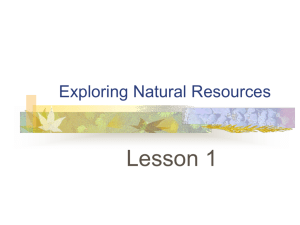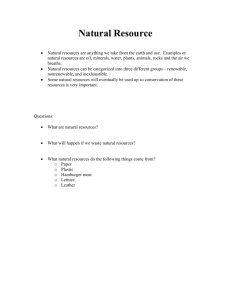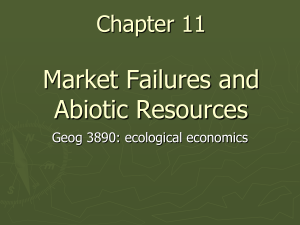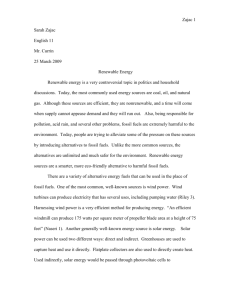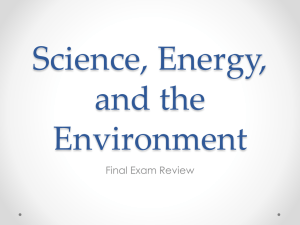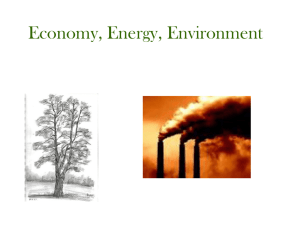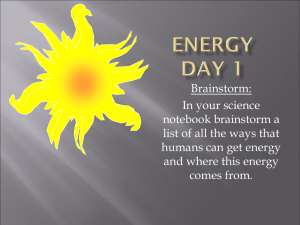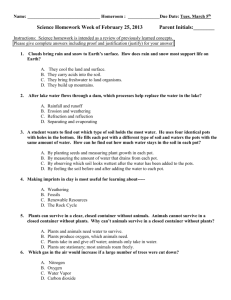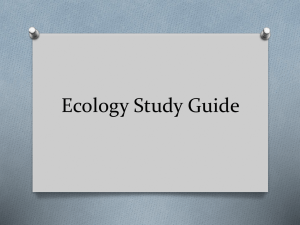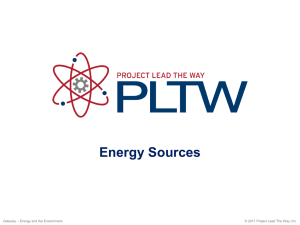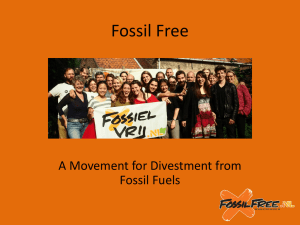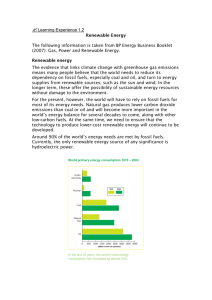B. Inexhaustible Natural Resource
advertisement
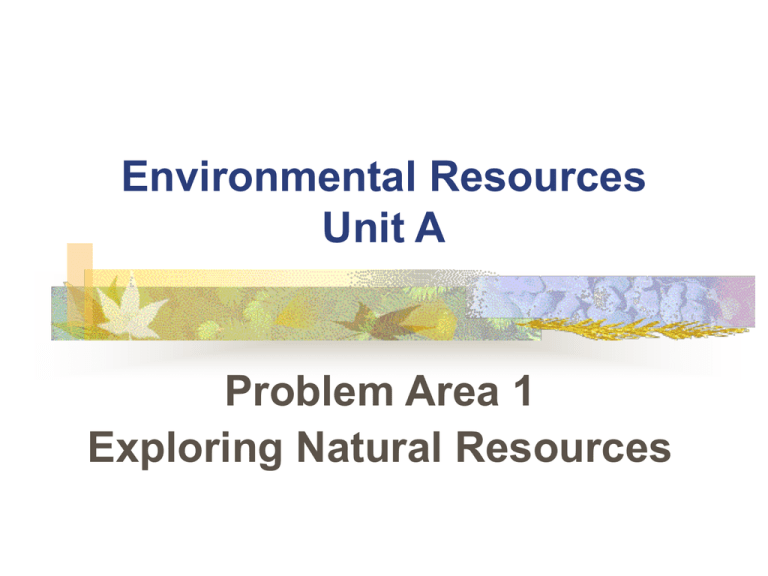
Environmental Resources Unit A Problem Area 1 Exploring Natural Resources What is around you? Examine your surroundings, write down everything that is living or was once living. Think about what you are wearing, where you are sitting, what you are writing on, etc. What would life on earth be like without these items? Learning Objectives Define and identify types of natural resources. Distinguish between renewable and nonrenewable resources. Explain the difference between inexhaustible and exhaustible resources. Explain the concept of interdependent relationships. Terms Air Atmosphere Climate Domestication Environment Exhaustibility Exhaustible natural resource Fossil fuels Inexhaustible natural resource Minerals Natural resource dependence Terms Natural resources Nonrenewable natural resources Renewability Renewable natural resources Soil Water Water cycle Weather Wildlife Wind I. Types of Natural Resources A. Natural resources Resources that occur naturally in nature B. The environment is the conditions that surround us I. Types of Natural Resources C. Natural resources cannot be made by man, but man can help ensure their continued existence D. People need many natural resources to live E. Other natural resources are used to make life easier II. Natural Resources Groups A. Air and wind B. Fossil fuels C. Minerals D. People E. Soil F. Sunlight G. Water H. Wildlife A. Air and Wind 1. The atmosphere is the area surrounding the Earth a. Air is the mixture of gases that surrounds the Earth b. Wind is the movement of air c. Water vapor, gases, and particulate can be found in the atmosphere A. Air and Wind 2. Weather - the conditions found in the atmosphere a. includes moisture, humidity, temperature, movement, and pressure A. Air and Wind 3. Climate of an area helps determines which natural resources are found in an area a. Climate - the condition of the weather in a particular location (rainfall, temperature, humidity, etc.) B. Fossil Fuels 1. Fossil fuels are natural resources used to provide energy a. Fossil fuels took millions of years to make b. The remains of decomposed plants and animals c. Their energy comes from the energy produced by the plants and animals 2. Fossil Fuel Groups a. Petroleum - liquid form of fossil fuels used to make gasoline and oils 2. Fossil Fuel Groups b. Natural gas - gaseous form of fossil fuels used in heating and cooking 2. Fossil Fuel Groups c. Coal – solid form of fossil fuels used in factories and in generating electricity C. Minerals 1. Natural inorganic substances on or in the earth 2. Abiotic 3. Mined from the earth 4. Iron, brick, jewelry, coins, monuments, and concrete D. People 1. Help determine how other natural resources are used 2. As population increases, natural resource use will increase 3. Wise use of resources is necessary to ensure their future availability E. Soil 1. Outer layer of the earth’s surface that supports life 2. Plants grow in soil, humans and other animals eat plants, humans and animals produce waste that provides nutrients for plants to grow, and the cycle continues 3. soil can be easily eroded by misuse and neglect 4. Soil must be protected in order for it to continue to be a resource F. Sunlight 1. The source of almost all the energy used on Earth 2. The light from the sun produces solar energy a. Autotroph, Heterotroph, Photosynthesis, Cellular Respiration b. People can also use this energy by using solar collectors G. Water 1. A tasteless, colorless, liquid natural resource 2. ALL living things need water to survive 3. Water is a naturally occurring compound made up of 2 atoms of Hydrogen and 1 atom of Oxygen 4. Water can be found in three forms, solid, liquid, and gas 5. Water Cycle a. Movement of water from the earth’s surface to the atmosphere and back to the surface b. Water is continuously renewed/recycled through the hydrologic cycle H. Wildlife 1. All of the plants and animals that live in the wild 2. Have not been domesticated III. Renewable and Nonrenewable Resources A. Renewability is whether or not a resource can be restored after use B. Renewable Natural Resources 1. Natural resources that can be replaced after use 2. They can be renewed and used again, but it may take many years 3. Soil is a renewable natural resource, however it is not a fast process 4. Plants and water are other renewable natural resources C. Nonrenewable Natural Resources 1. Natural resources that cannot be replaced after use 2. Minerals and fossils fuels are two types IV. Inexhaustible and Exhaustible Natural Resources A. Exhaustibility - whether or not a natural resource can be replenished as it is used B. Inexhaustible Natural Resource 1. A resource that is continuously replenished; the supply of the resource will not run out 2. Sunlight, wind, and water are inexhaustible natural resources C. Exhaustible Natural Resource 1. A resource that is available in limited quantity and can be completely used 2. Can be replaceable or irreplaceable a. replaceable natural resource can be replenished - most wildlife b. irreplaceable natural resource - gone once it is used - fossil fuels and most minerals V. Interdependent Relationships A. ALL natural resources depend on each other B. This means that all living things depend on each other V. Interdependent Relationships C. Humans need animals for food, clothing, and work D. Plants are used for food, medicine, and oxygen V. Interdependent Relationships E. Plants depend on animals and humans F. Animals give off carbon dioxide that the plants need G. When organisms die, they decompose releasing minerals back into the soil for plants Review/Summary Define and identify types of natural resources. Distinguish between renewable and nonrenewable resources. Explain the difference between inexhaustible and exhaustible resources. Explain the concept of interdependent relationships.
